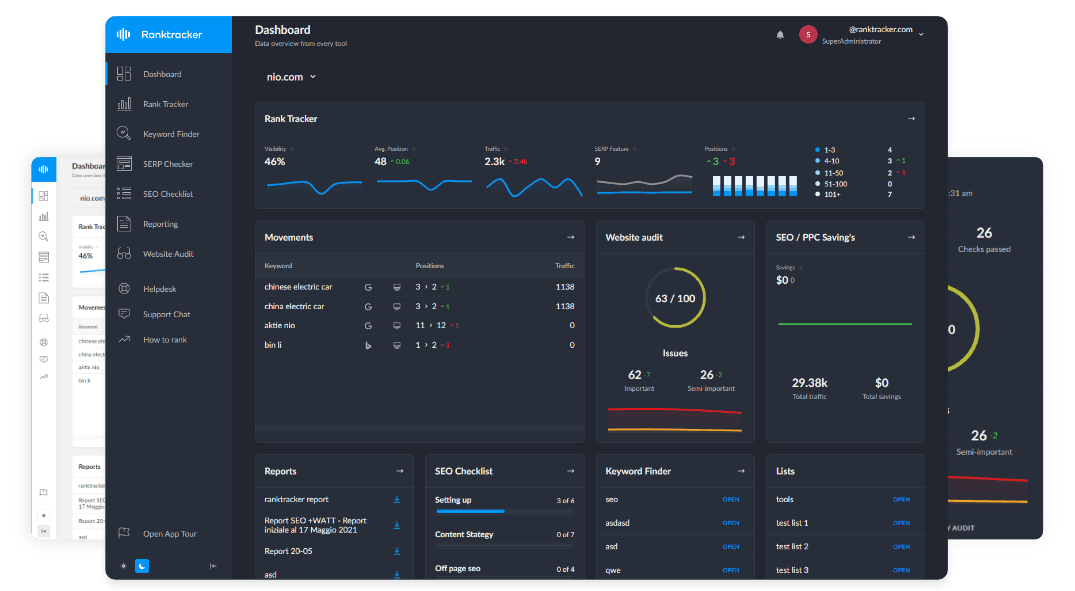Intro
Millions of people search each year for lost relatives, ancestry records, and DNA connections—but unless your genealogy site is ranking, they’ll never find your resources. Whether you offer a research service, maintain a genealogy blog, or sell family tree tools, SEO is the key to visibility and authority.
With Ranktracker’s suite of SEO tools, you can attract more researchers, hobbyists, and history lovers while building long-term trust with content that ranks and converts.
Why SEO Is Essential for Genealogy and Ancestry Websites
People interested in genealogy are typically information-hungry and emotionally invested in finding answers. They actively search for records, guides, services, and tools that can help them trace their lineage.
SEO helps your genealogy brand:
-
Capture traffic from high-intent searchers like “how to trace Irish ancestry”
-
Rank for long-tail educational searches such as “what is a third cousin once removed”
-
Drive leads for paid genealogy research or coaching
-
Sell digital products like family tree templates, guides, or access to archives
-
Build backlinks and authority by providing historical or niche expertise
Monitor your keyword rankings with Ranktracker’s Rank Tracker to stay ahead of competitors in this research-driven space.
Keyword Research: Target Generational, Geographical, and Historical Queries
Genealogy searchers often look for information that’s highly specific to geography, surname, generation, or ethnic heritage.
Use Ranktracker’s Keyword Finder to uncover search terms like:
-
“how to build a family tree for free”
-
“find birth records from Poland”
-
“best genealogy websites 2025”
-
“free African American ancestry search tools”
-
“how to research German ancestry online”
-
“what is GEDCOM file format”
-
“old census records by address”
-
“DNA matches but no common ancestor”
-
“organize genealogy research binder”
Segment keyword targets by:
-
Geography: Polish, Irish, Native American, Jewish, etc.
-
Tools: software, printable templates, databases
-
Records: birth, death, marriage, census, immigration
-
Generations: grandparents, great-grandparents, Civil War era, etc.
-
Search type: how-tos, definitions, troubleshooting, templates
On-Page SEO: Create Pages That Guide and Convert
Your content must be both informational and actionable. Each landing page should speak directly to a user intent—whether they're looking to learn, research, or buy.
On-page SEO essentials for genealogy websites:
-
Title Tag: “Trace Your Irish Ancestors: A Step-by-Step Guide (2025)”
-
URL:
/research/trace-irish-ancestry/ -
Meta Description: “Start tracing your Irish roots with this beginner-friendly genealogy guide. Learn where to find birth records, census data, and surnames.”
-
Header tags (H1, H2): Use question-style H2s to target informational searches
-
FAQ Schema: Answer common questions like “How far back can DNA tests go?”
-
Internal Linking: Link to surname directories, region-specific record guides, and downloadable resources
-
CTAs: “Start Your Family Tree,” “Request a Record Search,” “Download Research Planner”
Use Ranktracker’s SERP Simulator to preview how each page will appear in search.
Content Marketing: Become the Trusted Source for Family History Enthusiasts
Content is crucial for ranking in this niche. Users need help interpreting old records, understanding kinship terms, and navigating confusing genealogy tools.
Content ideas for SEO and trust-building:
-
“Beginner’s Guide to Building Your Family Tree”
-
“The Difference Between AncestryDNA and 23andMe”
-
“How to Read Old Census Records and What They Mean”
-
“Top Free Genealogy Databases by Country”
-
“Understanding Cousin Relationships: 2nd, 3rd, Once Removed”
-
“How to Start a Family History Blog”
-
“Organizing Your Research: Binders, Spreadsheets, and Tools”
Use Ranktracker’s AI Article Writer to scale educational content efficiently, especially for long-tail and evergreen queries.
Technical SEO: Ensure Your Archives, Trees, and Tools Load Seamlessly
Genealogy sites often host large datasets, old image scans, and embedded charts—all of which can slow things down. Speed and usability are critical.
The All-in-One Platform for Effective SEO
Behind every successful business is a strong SEO campaign. But with countless optimization tools and techniques out there to choose from, it can be hard to know where to start. Well, fear no more, cause I've got just the thing to help. Presenting the Ranktracker all-in-one platform for effective SEO
We have finally opened registration to Ranktracker absolutely free!
Create a free accountOr Sign in using your credentials
Use Ranktracker’s Web Audit to fix issues like:
-
Slow page load speeds (especially image-heavy archive pages)
-
Unindexed or duplicate pages due to dynamic search results
-
Missing or incomplete schema markup for articles, tools, and downloads
-
Mobile usability errors (especially with interactive family tree builders)
-
Poor internal linking from content pages to tools or services
Visual SEO: Use Images, Trees, and Records to Build Trust and Engagement
Genealogy is highly visual—family trees, documents, and photos drive both credibility and emotional connection.
Image optimization tactics:
-
File names:
1930-census-record-template.jpg,polish-family-tree-example-2025.png -
Alt text: “Sample family tree showing five generations of Polish ancestry”
-
Use infographics: “Kinship Terms Explained” or “Timeline of Ancestry Research Steps”
-
Embed sample charts, GEDCOM file visuals, or side-by-side record comparisons
-
Add schema to image galleries and media-heavy posts
Backlinks & Authority Building: Be Cited by Libraries, Archives, and Genealogists
In this space, backlinks are won through helpfulness and citation. Give people a reason to reference your site.
Link-building strategies for genealogy SEO:
-
Publish original surname or regional guides others can reference
-
Partner with genealogy bloggers, ancestry YouTubers, and forum moderators
-
Submit how-to articles to historical societies and library resource pages
-
Be listed in “Top 10 Genealogy Sites” roundups or research tool lists
-
Offer free downloadable templates in exchange for backlinks
Track new and lost links with Ranktracker’s Backlink Monitor.
Reputation & Social Proof: Build Trust with Your Reader Community
People want to know that your records, templates, or guidance can be trusted. Use testimonials and UGC to boost credibility.
Tactics to build trust:
-
Highlight testimonials from successful research clients or happy readers
-
Display reviews of your templates or services
-
Create a “Community Finds” section with stories and success screenshots
-
Encourage user-generated content (e.g., photos of printed trees or record finds)
-
Build a private genealogy Facebook group or forum
Use Ranktracker’s Reputation Management tool to monitor brand mentions across the web.
SEO Checklist for Genealogy Websites
-
Research keywords by region, generation, and record type
-
Use schema (Article, FAQ, Product, LocalBusiness) on appropriate pages
-
Create deep content for every stage of the research journey
-
Optimize images, infographics, and family tree visuals
-
Monitor site speed and indexing issues with Ranktracker’s Web Audit
-
Get cited on blogs, forums, and educational resources
-
Showcase reviews, testimonials, and family history success stories
-
Track performance, rankings, and backlinks weekly
Conclusion
Genealogy isn’t just a hobby—it’s a deeply personal journey. With the right SEO strategy and Ranktracker’s tools, your site can guide users through the most meaningful searches of their lives. Help them discover their story, one optimized page at a time.

